
 Jack Dawkins
The Hockey Writers
Jack Dawkins
The Hockey Writers
33
Reads
0
Comments
Wild’s Prospect Problem & Guerin’s Plan to Fix It
The Minnesota Wild have a prospect problem. It’s on the verge of being fixed, but it’s up to current general manager, Bill Guerin, to continue fixing it.
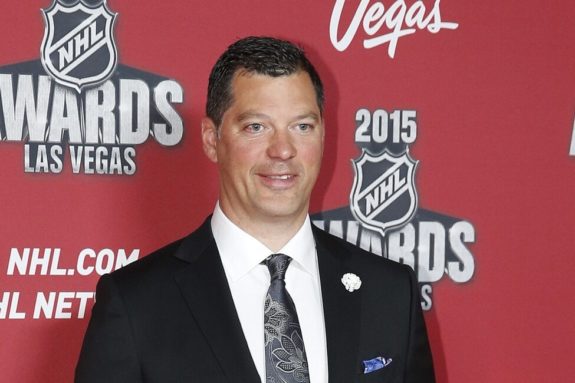
In order to keep the franchise moving forward towards becoming a contender in the Western Conference, Guerin will have to be smart, shrewd and downright devious. He’s also going to have to do it while rebuilding the major departments he will rely on for his information and mitigating the damage of his predecessors.
Where Did the Trouble Start?
The problem began in 2013. Coming off a 4-year playoff drought, then-GM Chuck Fletcher decided to add to his team at the trade deadline. The Wild were riding high. They had inked the gargantuan Zach Parise and Ryan Suter deals in free agency during the offseason and both players had arrived as advertised. The playoff-bound Wild wanted to gear up and make a real run. To that end, they traded a 2013 first-round pick, a 2014 second-round pick, Johan Larsson and Matt Hacket to the Buffalo Sabres for Jason Pominville and a 2014 fourth-round pick.
Then it Snowballed
This trade is the first ripple of trouble. After the Wild acquired Pominville, they re-signed him. He had two productive seasons in Minnesota, but this acquisition coupled with the Suter and Parise contracts pigeonholed the Wild into a place where they had to maintain their level of competition.
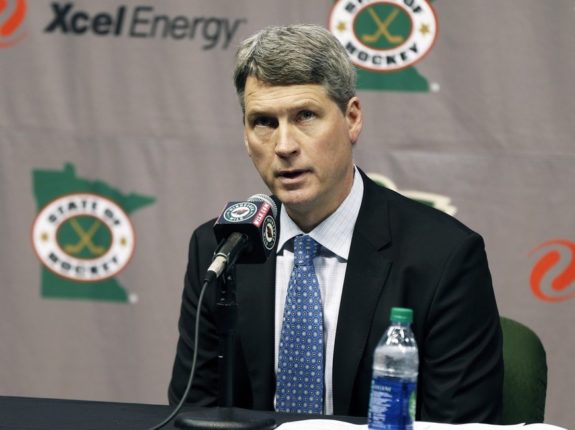
This jived with owner Craig Leipold’s perpetual “win now” mindset. The downside was that they were trying to do this in an era of really strong Western Conference teams. As each trade deadline passed, the Wild traded out draft picks and prospects for rental players.
| Trade Deadline Year | The Wild Traded Away | The Wild Received |
| 2013 | To Buffalo: Matt Hackett, Johan Larsson, 2013 1st RD Pick, 2014 2nd RD Pick | Jason Pominville, 2014 4th RD Pick |
| 2014 | To Buffalo: Torrey Mitchell, 2014 2nd RD Pick, 2016 2nd RD Pick | Matt Moulson, Cody McCormick |
| 2015 | To Buffalo: 2017 2nd RD Pick | Chris Stewart |
| 2016 | no deadline deals made | |
| 2017 | To Arizona: Grayson Downing, 2017 1st RD Pick, 2018 2nd RD Pick, 2019 Conditional 4th RD Pick | Martin Hanzal, Ryan White, 2017 4th RD Pick |
From 2013 to 2018, Fletcher traded away 6 of 12 first- and second- round picks. Without their top picks, the Wild had a gaping hole in their talent pool. The Pominville trade was not as bad as some of the subsequent ones. At least Fletcher signed Pominville and got some value out of the picks he traded away. Stewart, Moulson and Hanzal were all rental players who left once the season was over.
Related: Wild Go All-In with Hanzal
To his credit, Fletcher’s strategy to keep the Wild in the playoffs kind of worked. They were in the postseason every year from 2013 to 2018, but they exited in the first round four times and the second round twice. The team’s playoff success was disproportionate to the assets Fletcher sold to keep them there.
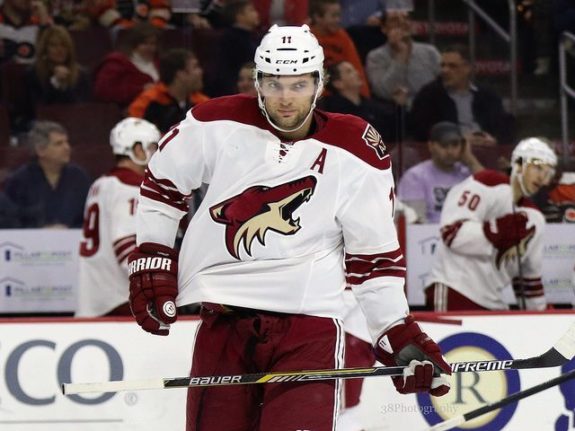
Because they continued to make the playoffs, the first-round picks that they didn’t trade were not lottery picks, so the Wild missed out on opportunities to draft talent from the upper echelon of the first round. As a result, they were reliant on their scouting department to find talent in the later rounds and scout potentially viable undrafted free agents to continue supplementing the roster with fresh young talent. That did not happen often enough.
Related: Changes Needed For The Wild
Roster attrition is inevitable in the NHL. Young players become more expensive as they mature and improve, just as older players lose their effectiveness over time. The only way to keep a team competitive is with a steady flow of talent from the prospect system. Trying to find a Wild draft pick who was selected outside the top two rounds and worked out for the organization during the Fletcher years, requires some digging.
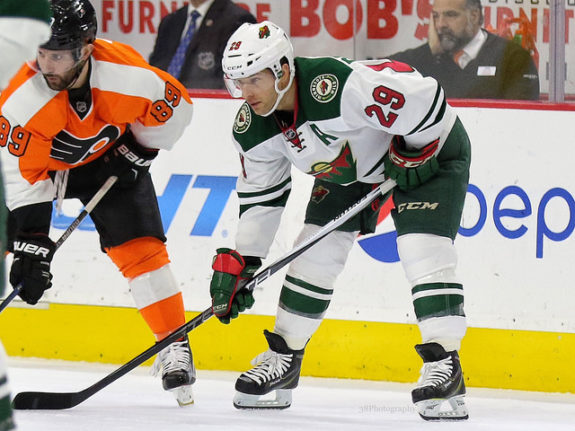
You have to go back to 2009 when they drafted Erik Haula in the seventh round. This season, a fifth-rounder from 2013, Carson Soucy, made an impact on the back end. His role going forward remains to be seen. Kirill Kaprizov is expected to be a star and he was a fifth rounder in 2015. However, in March 2020, the Wild have not had any other players selected by Fletcher outside the first two rounds, cycle in and become a mainstay on their roster.
Enter Paul Fenton
That cycle seems to be changing. Kaprizov and Soucy were mentioned, and they should have a role on the team going forward. The 2018 and 2019 Draft classes are full of prospects who project to be contributors to the Wild down the line. Paul Fenton, who took over as GM in 2018, did not trade away picks. He didn’t have a second-round pick in 2018 because Fletcher had traded it the season before. To his credit, Fenton understood the value of the draft and began restocking a decimated prospect pool, and he appears to have been successful.
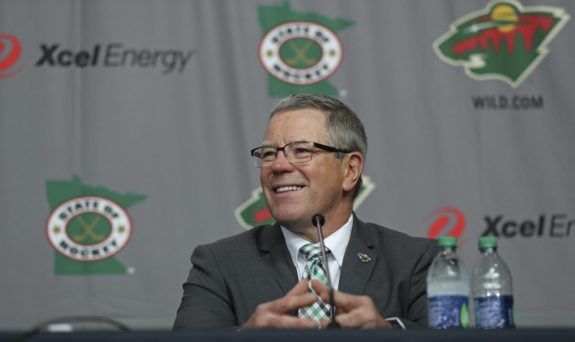
However, he also made mistakes that compounded other problems and he lasted only 14 months in Minnesota. His departure had as much to do with decisions he made regarding off-ice personnel as it did players, (from ‘The downfall of Paul Fenton: Inside the GM’s turbulent 14 months with the Wild,’ The Athletic, 08/02/2019). The deals that shipped out Charlie Coyle and Nino Niederreiter didn’t receive enough value in return, but some of his smaller personnel moves were just as questionable. His acquisition of Pontus Aberg went poorly and claiming Anthony Bitetto off waivers also didn’t pan out.
Related: Analyzing Fenton’s Brief Tenure as the Wild’s GM
Worse than that, Fenton’s paranoia about media leaks and demoting key personnel had deteriorated the culture of the front office. The Wild lost important members of their management, scouting, coaching and analytics departments. A huge part of Guerin’s job will be to rebuild trust within the organization and replace the quality personnel who left or were fired under Fenton.
Don’t Call It a Rebuild
To his credit, Guerin seems to have a plan. Trading (homegrown talent) Jason Zucker is the only deal Guerin has made in his tenure with the Wild, and the return was excellent. Defender Calen Addison immediately became the organization’s best defensive prospect, and the conditional first-round pick guarantees Minnesota another top-40 prospect in either the 2020 or 2021 Drafts. Whether or not Guerin decides to extend Alex Galchenyuk is effectively a bonus round for him. The pick and the prospect were a good enough return.
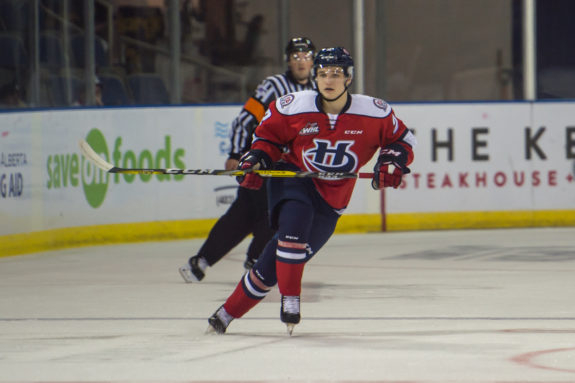
The Wild have also moved ahead with getting some of their 2018 and 2019 picks under contract in anticipation of the offseason ahead. Forward Damien Giroux and goaltender Hunter Jones should be AHL eligible. Adam Beckman’s breakout 107-point season in Spokane moved him up the depth chart and put him in position to take a shot at making the big club out of training camp.
Related: Wild Prospects – Matthew Boldy’s Strong February Saves Freshman Season
The Wild have also been busy scouting the undrafted free agent NCAA market. Guerin inked UMass (Amherst) forward, Mitchell Chaffee to a 2-year, entry-level deal. Chaffee was the captain of the Minutemen this season and has been a consistent points contributor for three years with the team. The Rockford Michigan native was considered one of the top college free agents available and the Wild got him.
Adding a top NCAA free agent is like “found money” because they are further along in their development. Chaffee’s NHL draft year would have been 2016 so, in a way, signing Chaffee is like gaining back a lost pick from the 2016 Draft.
The Swedish Elephant in the Room
The next big question for Guerin is regarding the future of 2018 first-round pick, Filip Johansson. It’s hard to imagine the Wild are elated with the 20-year-old’s development since they drafted him two seasons ago. Although Johansson became a full-time SHL defender with Leksands, he only averaged 13:26 of ice time per game. He’s slated to play for Frolunda next season.
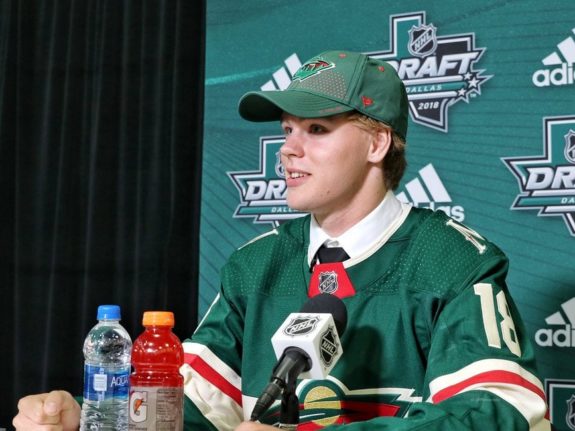
His skating and defensive play are still his strong suits, but he is not developing the kind of offensive upside that teams would like to see from a first-round pick. Frolunda is hoping he can develop that part of his game and they have him signed through 2022. If the Wild are unwilling to wait until then to see if he can cut it in North America, they may look for a trading partner who is.
It’s hard to guess what kind of a return Guerin could get for him, and it would depend on what other scouting departments thought of him. It was surprising when Fenton selected him in the first round (from ‘Wild takes Swedish defenseman Filip Johansson with 24th pick,’ Star Tribune, 06/23/2018). If Guerin can get a piece he likes, it might be worth making the move.
Related: Revisiting the Brent Burns Trade
To be successful, Guerin is going to have to make more trades like the Zucker trade, more signings like the Chaffee signing. and rebuild the management culture of the Wild. The draft picks that Fletcher gambled away did not bring the Wild any closer to a Stanley Cup Final; and in 14 months, Fenton decimated the culture of the organization. So far, the team seems to be back on track and this general manager has shown that he’s the man with the plan to keep it going in that direction.
The post Wild’s Prospect Problem & Guerin’s Plan to Fix It appeared first on The Hockey Writers.
Popular Articles

















































 Canucks Vancouver
Canucks Vancouver Sharks San Jose
Sharks San Jose Flames Calgary
Flames Calgary Avalanche Colorado
Avalanche Colorado Coyotes Arizona
Coyotes Arizona Golden Knights Vegas
Golden Knights Vegas Wild Minnesota
Wild Minnesota Red Wings Detroit
Red Wings Detroit Blues St. Louis
Blues St. Louis Blackhawks Chicago
Blackhawks Chicago Blue Jackets Columbus
Blue Jackets Columbus Hurricanes Carolina
Hurricanes Carolina Jets Winnipeg
Jets Winnipeg Predators Nashville
Predators Nashville Ducks Anaheim
Ducks Anaheim Oilers Edmonton
Oilers Edmonton Sabres Buffalo
Sabres Buffalo Rangers New York
Rangers New York Bruins Boston
Bruins Boston Panthers Florida
Panthers Florida Senators Ottawa
Senators Ottawa Lightning Tampa Bay
Lightning Tampa Bay Capitals Washington
Capitals Washington Islanders New York
Islanders New York Devils New Jersey
Devils New Jersey Maple Leafs Toronto
Maple Leafs Toronto Flyers Philadelphia
Flyers Philadelphia Penguins Pittsburgh
Penguins Pittsburgh Stars Dallas
Stars Dallas Kraken Seattle
Kraken Seattle Kings Los Angeles
Kings Los Angeles






